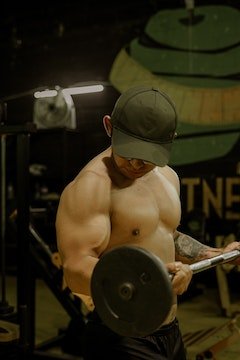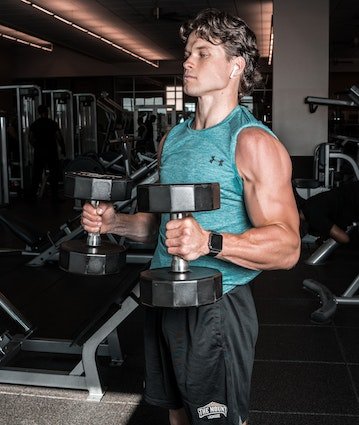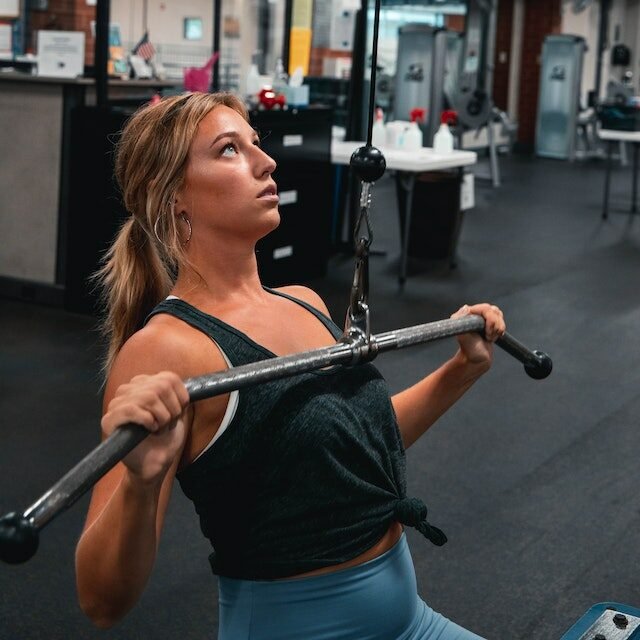
Why Do I Feel Biceps Curls In My Joints? 12 Crucial Factors To Solve The Problem Fast
Do you ever feel strange sensations in your joints when you do bicep curls? You’re not alone.
Many people experience this phenomenon, and it can be caused by a variety of factors. In this blog post, we will discuss the most common causes of joint pain during bicep curls and how to fix them.
I know how frustrating it can be to experience joint pain during a workout, so hopefully, this information will help you find relief and get you back to curling without any issues.
Not only will we provide tips on how to fix the pain, but we’ll also show you how to prevent it from happening in the first place. So let’s get started!
Why do I feel bicep curls in my joints?
There are several reasons why you might feel bicep curls in your joints. If you’re not using proper form when doing bicep curls, you’re more likely to experience joint pain. Make sure to keep your back straight, shoulders down, and core engaged throughout the entire movement. You might also want to check your grip. If you’re using a grip that’s too wide, you could be putting unnecessary strain on your joints. Instead, use a grip that’s about shoulder-width apart. If you’re gripping the barbell or dumbbell too tightly, you could be causing joint pain. Instead of gripping the weight tightly, try to relax your grip and focus on using your biceps to curl the weight. If the weight you’re using is too heavy, you could be putting unnecessary strain on your joints. Make sure to start light and gradually increase the weight as you get stronger. If your wrists are flexed or extended during the bicep curl, you could be putting strain on your joints. Instead, keep your wrists in a neutral position throughout the entire movement. Another common cause of joint pain is rushing through the movement. If you’re not taking the time to control the weight, you could be putting strain on your joints. Instead, focus on moving the weight slowly and with control. When you lower the weight during a bicep curl, gravity is working against you. This can put strain on your joints if you’re not careful. Instead of dropping the weight, lower it slowly and under control. If your arms are locking out at the bottom of the bicep curl, you could be putting strain on your joints.
Let’s now look more closely at why this might be happening and how you can prevent it.
You aren’t used to doing them
If you’re new to working out, or if you’ve just started doing bicep curls, it’s possible that your joints aren’t used to the movement. This is especially true if you’re doing a lot of repetitions.
When you first start working out, your muscles will be weak and your joints will be unstable. As you continue to work out, your muscles will get stronger and your joints will become more stable. This process takes time, so be patient and don’t try to do too much too soon.
This may happen if you’ve been working out consistently for a while, but you’ve recently increased the intensity of your workouts. If this is the case, your muscles and joints may not be used to the new level of activity.
It’s important to gradually increase the intensity of your workouts so that your muscles and joints can adapt. If you increase the intensity too quickly, you may experience joint pain.
You’re not using proper form
If you’re not using proper form when doing bicep curls, you’re more likely to experience joint pain.
Make sure to keep your back straight, shoulders down, and core engaged throughout the entire movement. An important part of the movement that sometimes gets overlooked is keeping your elbows tucked into the side of your torso while you curl the weight.
There are a few things to look out for when doing bicep curls which could make the difference between pain-free joints or aching muscles and joints.

Grip factor
If you’re gripping the barbell or dumbbell too tightly, you could be causing joint pain, this is because the pressure you’re putting on your joints can irritate them.
Holding the bar too tight will also increase tension in your muscles, which can lead to fatigue and pain. Instead of gripping the weight tightly, try to relax your grip and focus on using your biceps to curl the weight.
Always grip the bar or dumbbell with your palms facing up (supinated grip). This will help you to engage your biceps more effectively and get the most out of the exercise.
If you’re using a grip that’s too wide, you could be putting unnecessary strain on your joints.
Instead, use a grip that’s about shoulder-width apart. This will help to keep the pressure off of your joints and allow you to focus on using your biceps to curl the weight.
Related: Why Do I Get Thumb Pain Doing Dumbbell Curls?
Too heavy
If the weight you’re using is too heavy, you could be putting unnecessary strain on your joints. Make sure to start light and gradually increase the weight as you get stronger.
Going too heavy will not only potentially strain your joints but also cause serious injury. We all want to lift to the maximum of our capabilities, but you also have to be reasonable regarding the weight you’re using.
Going too heavy is one of the most common mistakes people make, which in turn compromises your form and puts unnecessary strain on your joints.
If you find that your elbows aren’t glued to the side of your body when doing the movement, but are instead flaring out, the weight is too heavy.
Remember, it’s not about how much you can lift, but rather how effectively you can lift the weight.
If you can’t control the weight, you’re using too much. When doing bicep curls, focus on using a weight that you can control throughout the entire range of motion.
You’re not warming up properly
If you’re not warming up properly, you could be putting unnecessary strain on your joints.
Trying to do any form of exercise without warming up can lead to joint pain and injury, due to the fact that your muscles and joints will not be properly prepared for the activity.
Before starting your workout, make sure to warm up with some light cardio and dynamic stretches, it will help to loosen up your muscles and prepare them for the workout ahead.
Warming up helps to increase blood flow and lubricate your joints, which in turn will help to prevent injury and joint pain.
Having tight muscles can also contribute to joint pain, as they can put pressure on the joints.
Make sure to take the time to warm up properly before every workout. Warming up properly will help to prevent injury and increase the effectiveness of your workout.

You might have an injury
If you’ve been experiencing joint pain for an extended period, it’s possible that you might have an injury.
If the pain is severe or if you’re experiencing any other symptoms such as swelling, redness, or difficulty moving the joint, it’s important to see a doctor.
Joint pain can be caused by a variety of different injuries, such as:
strains – overstretching or tearing of a muscle or tendon
sprains – overstretching or tearing of a ligament
dislocations – when a bone pops out of its joint
fractures – when a bone is broken
Arthritis – a degenerative disease that causes inflammation and pain in the joints
tendinitis – inflammation of a tendon
bursitis – inflammation of a bursa (a small, fluid-filled sac that helps to cushion and protect the joints)
If you think you might have an injury, it’s important to see a doctor so that they can properly diagnose and treat the condition.
Related: Are Bicep Curls a Pain In your Neck?
Wrist flexion or extension
When doing bicep curls, make sure that your wrists are in a neutral position all the way through the exercise.
If there is any flexion or extension in the wrists of any kind, it can put unnecessary strain on the joints and lead to pain.
This is due to the wrists having to work more than they should to stabilise the weight and doing so can put a huge amount of strain on your joints and ligaments, especially when you are trying to lift a heavier weight than you are really able to curl.
If by any chance you find you are doing this without meaning to, it would suggest you are lifting a weight that is too heavy for you.
So, reduce the weight and keep an eye on your form to make sure your wrists remain neutral.
Are you rushing the movement?
When doing bicep curls, it’s important to take your time and focus on the quality of the movement, rather than the quantity.
If you rush the curl, you’re more likely to lose control of the weight and put unnecessary strain on your joints.
Instead, focus on slow and controlled movements. Take a deep breath in as you lower the weight down and exhale as you curl it back up.
The tempo of the curl should be slow and controlled, with a count of two seconds down and two seconds up.
This will help to ensure that you’re using the right muscles and putting less strain on your joints.
If the load is too heavy, you may find you are swinging or using momentum to get the weight up, rather than using your bicep muscle to curl it.
This is a sure sign you need to use a lighter weight.

Elbow hyperextension
When your arms are locked out at the bottom of the curl and your elbow is hyperextended, it puts a lot of strain on the joints.
This is because all the weight is resting on your elbow joint, which isn’t designed to support that much weight.
It’s also at this point where you might experience some of the extension in your wrists that we spoke about earlier, as the weight is now too close to your body with your elbows locked to be effectively supported.
To avoid this, make sure to keep a slight bend in your elbows at the bottom of the curl and keep the time under tension on your biceps. This will take the strain off your elbow joint and help to prevent injury.
This will help to ensure that you’re using the right muscles and putting less strain on your joints.
Related: Why Do I Feel Bicep Curls In My Triceps?
Curl volume
If you’re doing a lot of bicep curls in a short space of time, it’s possible that you could be overworking your joints.
This is because the repetitive nature of the exercise can put a lot of strain on the same joint, which can lead to inflammation and pain.
To avoid this, make sure to take regular breaks in between sets of bicep curls and give your joints a chance to recover.
You may also want to think about reducing the number of curls you are doing within a certain time frame.
If you are doing a lot of curls in a day, try to spread them out over a week instead, so that your joints have time to recover in between.
You should also make sure to incorporate other exercises into your workouts so that you’re not overworking the same muscle group.
This will help to ensure that you’re using the right muscles and putting less strain on your joints.
Muscles fatigued
When your muscles are tired, they are less able to support the weight and this can lead to joint pain.
To avoid this, make sure to warm up properly before your workout and focus on quality over quantity.
It’s also important to listen to your body and take a break when you need to. If your muscles are feeling tired, take a few minutes to rest before continuing your workout or consider changing up your fitness routine to allow your arms to get a sufficient amount of rest.
Making sure your arms and body get enough rest and recovery time is key to avoiding fatigue, joint pain and overtraining.
You should also make sure to incorporate other exercises into your workouts so that you’re not overworking the same muscle group.
Final thoughts…
If you’re experiencing bicep curls in your joints, it’s important to take a step back and assess your form.
Make sure to keep your back straight, shoulders down, and core engaged throughout the entire movement. You might also want to check your grip.
If you’re using a grip that’s too wide, you could be putting unnecessary strain on your joints. If you’re gripping the barbell or dumbbell too tightly, you could be causing joint pain. Instead, try to relax your grip and focus on using the muscles in your arms to curl the weight.
You should also make sure to warm up properly before your workout and focus on quality over quantity.
It’s also important to listen to your body and take a break when you need to. If your muscles are feeling tired, take a few minutes to rest before continuing your workout or consider changing up your fitness routine to allow your arms to get a sufficient amount of rest.
Finally, try to spread out your workouts so that you’re not overworking the same muscle group. This will help to ensure that you’re using the right muscles and putting less strain on your joints.
Have you experienced this problem when doing curls? Let us know how these tips worked for you in the comments below!


